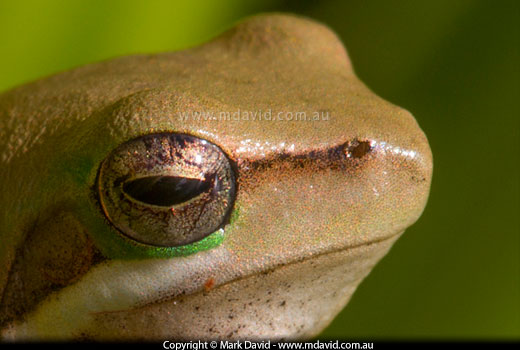
How tightly the pixels are packed into your camera’s sensor affects how much detail they can capture. Having enough pixel density therefore allows you to see more distant stuff. So it’s almost like having a longer lens.

A high pixel density combined with an APS-C camera’s framing came in handy photographing this little guy — an Eastern Dwarf Tree Frog.
Imagine you had a camera that captured zillions of megapixels. You could step outside your front door, take a snap, and then spend hours zooming in on the image on your computer to get the shot you wanted. You wouldn’t need a zoom lens because you could simply zoom in onscreen.
Does that sound like science fiction? Good. Because science fiction is pretty much what it is. Assuming you could even build a camera with so many megapixels you’d need almost infinitely good lenses and camera technique to capture so much distant detail without just getting a whole lot of blur. And distance haze would make everything on the horizon pretty much invisible anyway.
But you get the idea. By having more pixels in your sensor you can capture more detail for zooming in onscreen later.
This, combined with tight framing, is at the heart of why some APS-C cameras can capture distant imagery in a way that beats some of the full-frame cameras.
APS-C versus full-frame
Before I go on, I’m assuming you know what I mean by APS-C versus full frame, especially in how the APC-C crops the sides off images in a way that’s similar to using a longer lens. But don’t worry if you don’t, because I explain that stuff in this article. So from now on, I’ll assume you have a basic idea about the differences.
Have a look at the graphic below, showing an APS-C camera alongside a full-frame camera. In this example, both cameras have sensors with the same number of megapixels. So in this case, the APS-C camera is using all of its 18-megapixels to capture just the top of the flower, while that same portion of the flower is only captured by some of the 18 megapixels of the full-frame sensor. In this example, the APS-C would capture detail in that flower head in a way that the full-frame camera can’t match, and so it really is like having a longer lens.
Now compare that with the next example (below). This time the APS-C camera only has 6 megapixels in its sensor compared with 18 megapixels in the full-frame. That changes things a lot.
Even though it’s still using all of its megapixels to capture the top portion of the flower, what it gets is more than matched by what’s recorded by the full-frame camera thanks to the full frame having so many more megapixels.
You see, the sensors in full-frame cameras are (very rough guide) about 2 and a half times bigger than their APS-C cousins. So if the full-frame camera sensor also has two and a half times more pixels in it, then the APS-C camera is really not giving you an advantage. Both cameras in this example would be capturing the top portion of the flower with about 6 megapixels, while the full-frame camera would record a lot of extra stuff around the sides as well. So you would be able to take a picture using the full-frame camera, crop off the outside bits of it and you end up with pretty much the same as what the APS-C camera got.
That’s why the density of pixels plus the size of the sensor, combine to determine what real advantage you get with the multiplier effect in cropped-sensor cameras.
Back to the article about APS-C versus full frame
So, more megapixels pixels is better, then. Right?
Sure. There are advantages in big megapixel counts. But there are disadvantages too. It all really depends on how much you want them.








